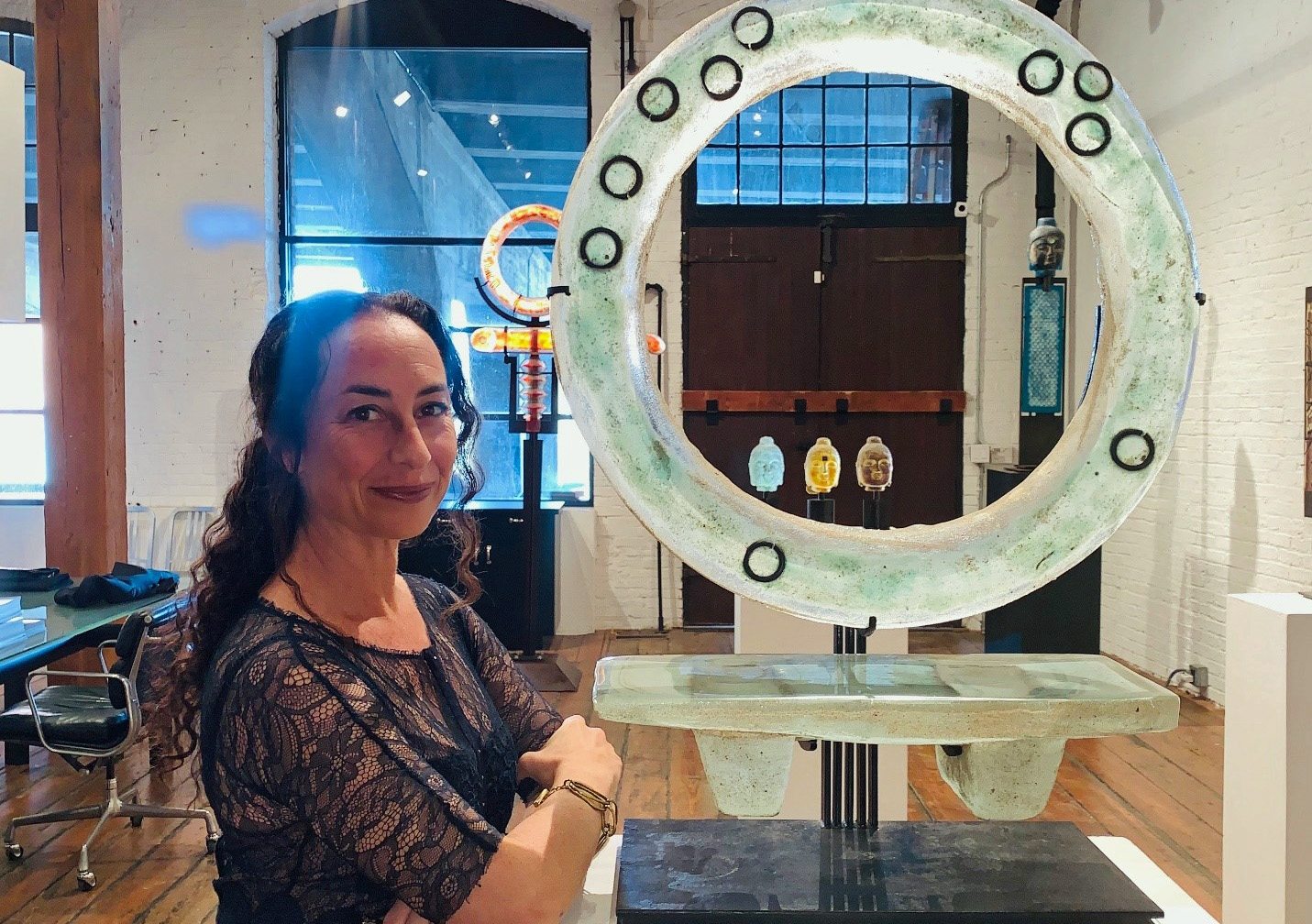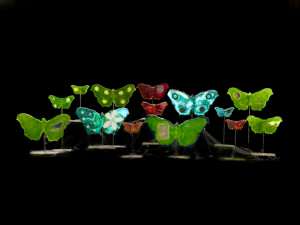Create
Out of the sand: Marlene Rose is unique among glass artists

While she was at art school in New Orleans, Marlene Rose learned how to blow glass, and how to work the tricky medium while it was hot, soft and malleable.
Her response? Meh.
“You can make this shape, you can adorn it, but what are you trying to say?” Rose remembers thinking. “To me, there wasn’t a statement. There wasn’t an expression, a communication, with this shape.”
The New York native had zero interest in creating functional pieces like pots or plates. “You can add all kinds of stuff to it, but in the end it’s a vessel,” she believes. “And I wanted to make sculpture.”
 For her, all the tumblers clicked into place when her professor introduced her to a relatively new glass-working technique called sand casting. A variation of centuries-old metal sculpting, it had only been applied to glass circa 1985, by an adventuresome artist in Sweden by the name of Bertil Vallien.
For her, all the tumblers clicked into place when her professor introduced her to a relatively new glass-working technique called sand casting. A variation of centuries-old metal sculpting, it had only been applied to glass circa 1985, by an adventuresome artist in Sweden by the name of Bertil Vallien.
Marlene Rose began learning the process in 1988. “Talk about falling into something really niche and unusual,” she says.
A mold is prepared using a combination of sand and bentonite, a form of clay that acts as a binding material. When an object is uniformly pressed into this mixture and carefully removed, an exact impression remains.
Next, liquid, molten glass – heated to more than 2,000 degrees Fahrenheit – is carefully ladled into the sand mold. Rose refers to this stuff as “lava.”
In this process, Marlene Rose the artist – along with Marlene Rose the adrenaline junkie who dances, plays soccer and lacrosse, rides horses and parachutes from airplanes – saw her future.
“It was experimental, it was dangerous, it was new,” she explains. “I wasn’t getting the positive feedback with my paintings at that point, or my other sculptures. There was something here, and I recognized the fact that something was different. I felt like I found my calling.”
She studied African art extensively while at Tulane University, and so her early works were mostly primitive. “It resonated with me, because I felt like when you break things down into bold, simple shapes and forms, but yet create this emotional impact … I wasn’t sure why I was so impacted by such very primitive lines and shapes.
“Then I started looking at a lot of other early cultures where they didn’t have a lot of technique and equipment. ‘Why am I so moved by certain cultures?’”
Before long came a romance with Asian art. “The Shang Dynasty absolutely floored me. And the Han Dynasty, it was 3,000 B.C. and to me they were making some of the most sophisticated works of art. It was just natural that I went east. Their sensibility, and calligraphy, it’s all about line and shape.”
 Her work, represented in 15 galleries internationally, includes abstracts, bells, butterflies, African and Asian-inspired designs and Buddha heads (“it represents serenity”), along with installations of all shapes and sizes. “I want people to be moved by the work,” Rose enthuses. “Uplifted.”
Her work, represented in 15 galleries internationally, includes abstracts, bells, butterflies, African and Asian-inspired designs and Buddha heads (“it represents serenity”), along with installations of all shapes and sizes. “I want people to be moved by the work,” Rose enthuses. “Uplifted.”
There are numerous methods of working with glass, all represented by fine artists with stories to tell and work to admire.
Sand casting, however, is so specialized that it’s almost an art form on its own. To the best of Rose’s knowledge, there’s only one other such artist, maybe two, in the Tampa Bay area.
As a form of expression, it was ideal for her from the start. “I loved the intimacy of a painting,” she says, “and I felt like I got that when I was working in the sand.”
Armed with an BFA from Tulane, Rose felt ready to face the world as a sand casting glass sculptor. “But then, the reality slapped me in the face: How do I make this work?” she remembers. “Because none of the studios are set up for this sort of thing. Glass blowers want it very clean and precise. They’re taking their work and they’re blowing it, they’re putting it in the cooling oven for maybe a day.”
The sand casting process requires a lot of space, and it can get sloppy, and recently-molten glass has to stay in a specialized cooling oven for a solid week. “A glass blowing studio that isn’t large enough wouldn’t want to share it with me because I’m going to take up their ovens for a week, and they can’t work.”
The process can’t be done in the kitchen, the garage or the back yard – it requires not only significant breathing room, but a special zoning permit. Lava is, after all, dangerous.
Rose traveled for a few years, and arrived in Pinellas County in 2003. It took a while to put aside the money for equipment, and to lease the right studio space. During that time, she worked in art galleries, and in public relations. She did what work she could out of the house she shared with her husband, architect Thomas Coates. She learned about the business of being a working, professional artist.
At college, she says, ‘I’d been smart enough to recognize that this particular work resonated with people. There was enough response to it that I said ‘This is what I want to do with my life.’
“It was a niche market, that I didn’t realize was niche. All I knew was that I was getting a lot of positive feedback. I didn’t think about an art career at that point.”
By 2010, she was most definitely thinking about it. She’d saved enough to get primo space, and the correct equipment, in a St. Petersburg studio. Collectors sought her out immediately.
The Marlene Rose Gallery, on Clearwater’s Cleveland Street many miles from the studio, opened four years ago.
 The gallery features a wide cross-section of her work, from the abstract to the obvious, from simple forms to elaborate constructions, each with a unique relationship to light and color, depending on the angle it’s viewed from.
The gallery features a wide cross-section of her work, from the abstract to the obvious, from simple forms to elaborate constructions, each with a unique relationship to light and color, depending on the angle it’s viewed from.
Trish Duggan, founder and benefactor of the Imagine Museum, was an early supporter. “I am most fortunate to have been the major collector of Marlene Rose’s gorgeous glass art creations that filled my home with sheer beauty,” Duggan gushes. “She is not only an amazingly creative artist, but is also an outstanding human being who helps others.”
Duggan dug in and learned, under Rose’s careful tutelage, the process and techniques of casting glass (“she’s the only student I’ve ever had,” Rose smiles). Through the artist, Duggan met Michigan glass artist, collector and curator Corey Hampson of Michigan’s Habatat Galleries, who recently opened his own St. Pete gallery.
“He helped me curate the stunning collection at Imagine Museum,” Duggan explains, “which I decided to open for the purpose of highlighting the top 60 American glass artists, including Marlene Rose.”
Rose will talk about her work this Sunday (May 19), from 10 a.m.until noon, at the Imagine Museum’s Coffee and Collections program. Tickets and info here.
There’s a raw, rugged beauty to Marlene Rose’s work. It’s entirely without the clean, polished fullness of most art glass, which of course comes in many shapes, sizes and forms.
It’s earthy, as if it were belched up ground alongside minerals and precious stones – something crude and colored, tough and translucent. But with form.
Rose knows why sand casting appealed to her in the beginning, and why it still does. “I love the texture of the sand on the glass,” she explains. “I love the fact that the glass remembers the sand. I had never seen the look of that on glass before, because traditionally, glass is smooth. And very smooth. No texture, no sand. This actually echoes my inspiration. Is this ancient? Is this technique old? So it kinda makes you think, unless you know that it’s a new technique for glass.
“And the other casting types that I was familiar with, they were poured in plaster so they have a milky-white color. It looked too perfect, somehow.”
And the immediacy of it – push something in the sand, take it out, there’s your mold – fed her craving or adrenaline. “With the rubber molds and the other mold-making techniques,” she points out, “there’s so many steps to the end product.
“There are still many steps to this. But it’s easy to learn, hard to master.”

Sand casting is physically demanding work – not to mention potentially lethal – and Rose is quick to praise her team, including her husband Thomas, for working with her every step of the way, from the hotbox to the gallery floor.







